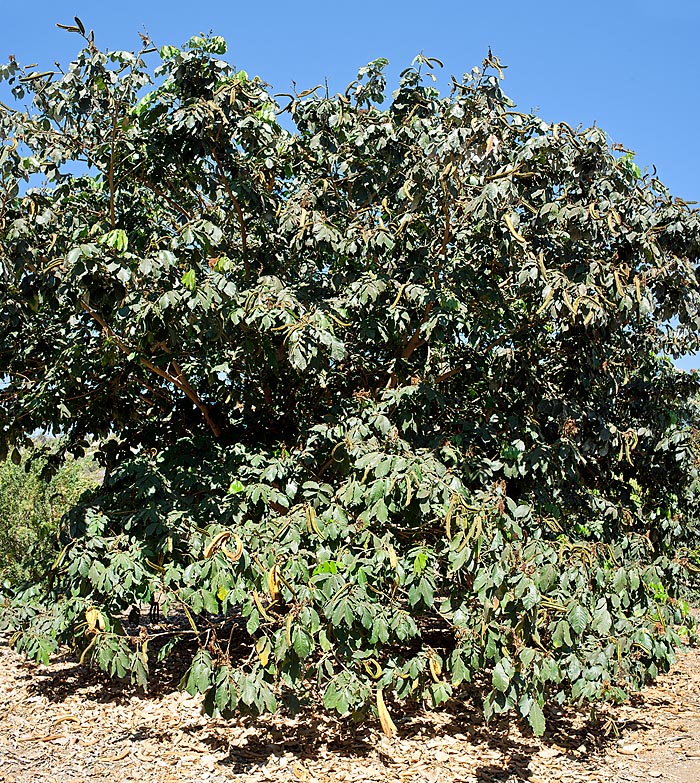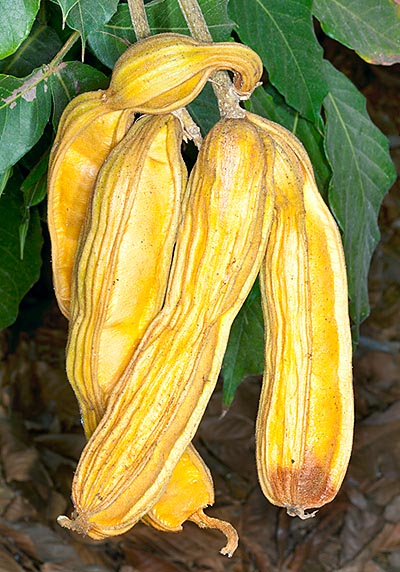Family : Fabaceae

Text © Pietro Puccio

English translation by Mario Beltramini

Even if kept lower, Inga feuilleei may exceed the 30 m © Giuseppe Mazza
The name of the genus is the one utilized by the natives; the species is honoured to the French astronomer, botanist and explorer Louis Éconches Feuillée (1660-1732).
Common names: ice-cream beans, food inga, inga bean (English); pois sucre (French); ingá cipo, pacae, pacay, rabo de mico (Portuguese-Brazil); pa’qay, paccai (Quechua); guama, guamo, pacae, pacae de costa, pacae de Lima, pacay, pacay de Perú (Spanish).
The Inga feuilleei DC. (1825) is a much ramified evergreen tree tall up to more than 30 m, even if in cultivation it keeps much lower, with trunk of 15-50 cm of diameter and pale brown bark.
It has 15-30 cm long paripinnate leaves, on short petiole, composed by 3-5 pairs of oval to elliptic leaflets with pointed apex, 5-12 cm long and 2,5-5 cm broad, of dark green colour, with a nectariferous gland at the base; the rachis between the pairs of leaflets is winged.
The inflorescences are axillar spikes 4 to 15 cm long carrying numerous hermaphrodite sessile (without peduncle) flowers, perfumed, with greenish tubular calyx 0,6-1,2 cm long, and yellowish tubular corolla with 5 lobes, 2-2,4 cm long, and several (about 100) white stamina 4-4,5 cm long, fused at the base in an about 1,5 cm long tube.

The quadrangular section fruits are indehiscent © Giuseppe Mazza
They containing 15-20 blackish seeds, glossy, surrounded by a fluffy aril having a sweet and refreshing taste.
It easily reproduces by seed which has a short-lasting germination capability, two weeks about, and that often germinates inside the pod, more unlikely by semi-woody cutting and air layering.
Fast growing species cultivable in the tropical and subtropical climate zones in full sun or filtered sunlight.
It does not stand the low temperatures, values of -1/-2 °C, even if for a short period, cause damage to the crown.
It adapts to various types of soil, from acidic to moderately alkaline, and being capable, like the other Fabaceae, to fix the atmospheric nitrogen enriching the soil with the same, thus contributes to its fertility; furthermore, the deep and robust root system helps in preventing erosion phenomena.
It is often utilized, in Peru in particular, as shade tree in parks and gardens, or as road tree, as well as for shading the plantations of coffee.
The aril, mainly appreciated by children, is useful also for preparing an alcoholic beverage, and in some places the seeds are consumed cooked, like in Mexico, where they are roasted.
The leaves and the seeds, with their high contents of proteins, are used as fodder for the livestock.
The wood is employed in the constructions and for realizing furniture, boxes and handicrafts and, locally, as fuel.
Synonyms: Inga feuillei DC. (1825); Inga cumingiana Benth. (1845); Inga edulis sensu auct.
→ To appreciate the biodiversity within the family of FABACEAE please click here.
